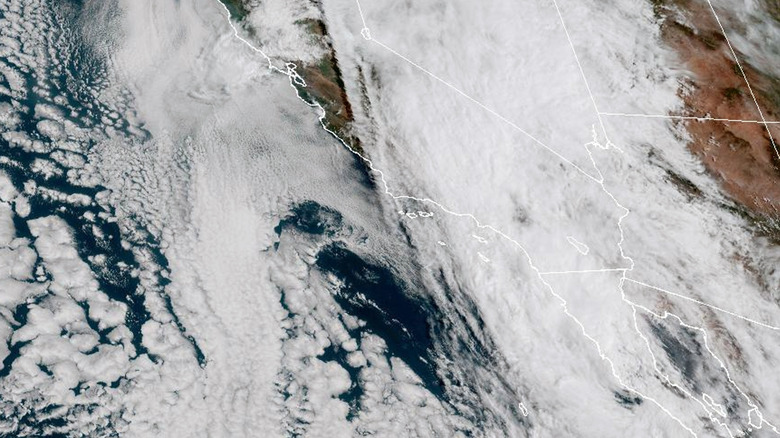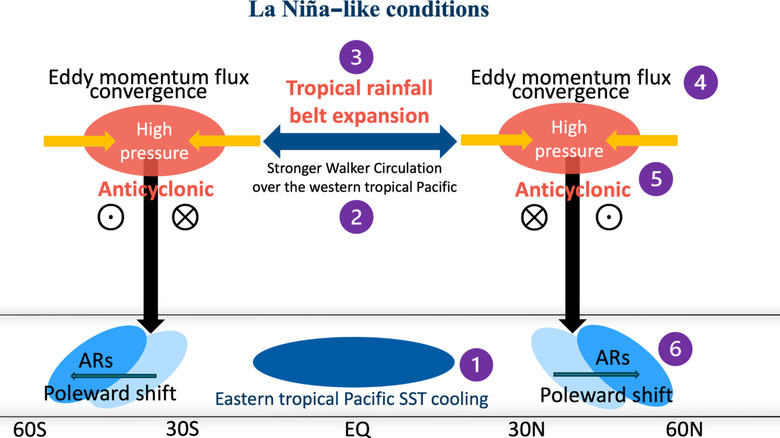This Atmospheric Phenomenon Is Drastically Changing Weather Around The World
High above our heads and unseen to the naked eye, rivers of water vapor flow through the atmosphere. These "atmospheric rivers" are crucial to the global water cycle. Astonishingly, they have the capacity to carry an amount of moisture that is equal to the water flowing from the mouth of the Amazon River. In the west of the U.S., these rivers are responsible for bringing snow to the Sierra Nevada and refilling California's reservoirs. Unfortunately, these rivers can also unleash destructive floods.
According to a 2024 study in the journal Science Advances, these highways of moisture have moved between 6 and 10 degrees closer to the Earth's poles over the past 40 years. That may not sound like much, but on the globe, it's roughly the distance between Los Angeles and central Oregon. This means that regions relying on a few of these storms each season for their annual water supply could suddenly face debilitating shortages, while regions in higher latitudes, which are unaccustomed to such intense rainfall, may be hit by storms they're not equipped to handle. These changes in Earth's weather patterns could impact agricultural yields, as well as increase the risk of disasters. Although interventions like cloud seeding can increase precipitation in areas prone to drought, techniques like this operate on a much smaller scale than the changes occurring with the atmospheric rivers.
Why atmospheric rivers are on the move
Study authors Zhe Li and Qinghua Ding attributed the leading cause of these changes to cooling ocean temperatures in the tropical eastern Pacific. For decades, this cooling trend has altered atmospheric circulation patterns and shifted the jet streams that guide these atmospheric rivers, they reported. Those shifts, often linked to persistent La Niña–like conditions, alter atmospheric circulation patterns.
Here's how it works: Sea surface temperatures cool in the eastern Pacific, causing tropical rainfall patterns to shift. This strengthens the high-pressure systems at the mid-latitudes, which then drives atmospheric rivers farther poleward. Li and Ding's study found that the frequency of atmospheric rivers has increased along 50 degrees north and 50 degrees south, while it has decreased along 30 degrees north and 30 degrees south since the late 1970s. Most of these changes are a result of natural processes, but climate change could play a role. That's because warmer atmospheres have the ability to hold more moisture, which could translate to atmospheric rivers unleashing heavier rainfalls with higher global temperatures.
The future of water and disaster management
The consequences of this poleward drift stretch beyond rainfall totals. Places like California could see more intense periods of droughts, while Alaska and British Columbia may face more frequent downpours. The Science Advances study states that under a high-emissions future, atmospheric rivers at higher latitudes could double in frequency by 2100, with major implications for Arctic ice melt. This is particularly concerning given the temperatures already being reported in Antarctica.
One of the main unanswered questions in relation to this atmospheric phenomenon is whether our existing infrastructure in vulnerable areas can handle these changes. Reservoirs designed to capture drinking water may not fill, and flood maps that were originally designed based on old rainfall patterns could fall out of sync with what is happening now. The world's atmospheric rivers are changing, and systems may need to adjust. Understanding these changes can help forecasters create better models and infrastructure that can protect regions against any potentially hazardous effects.


